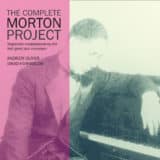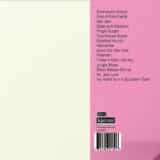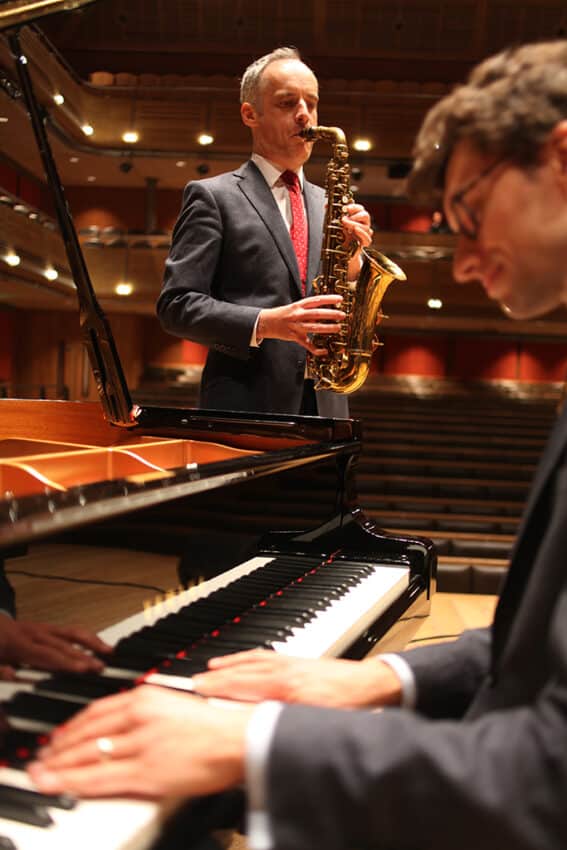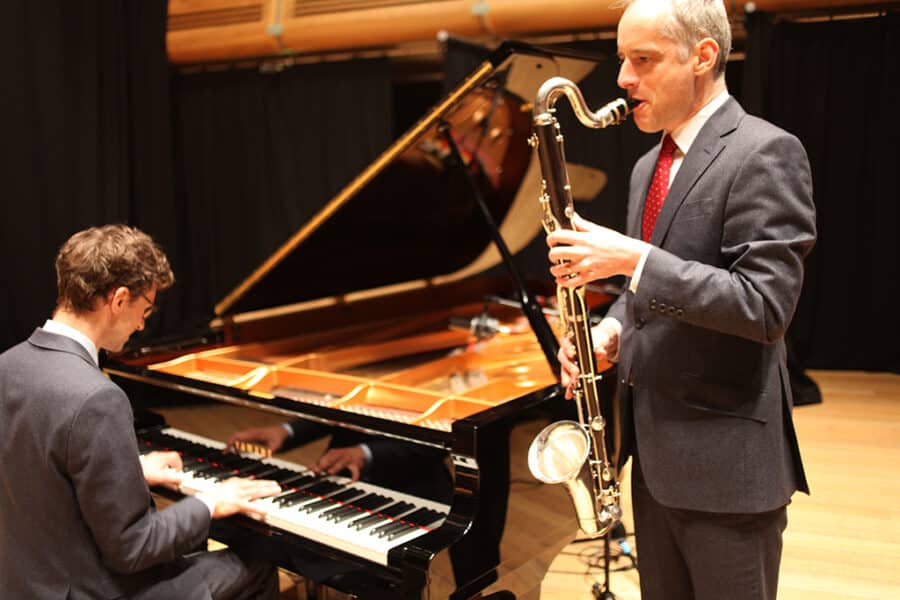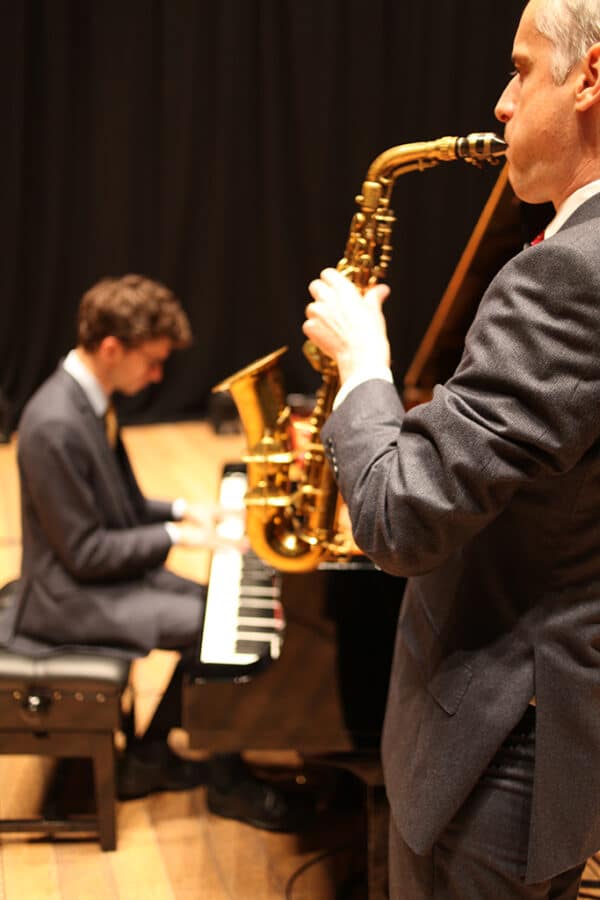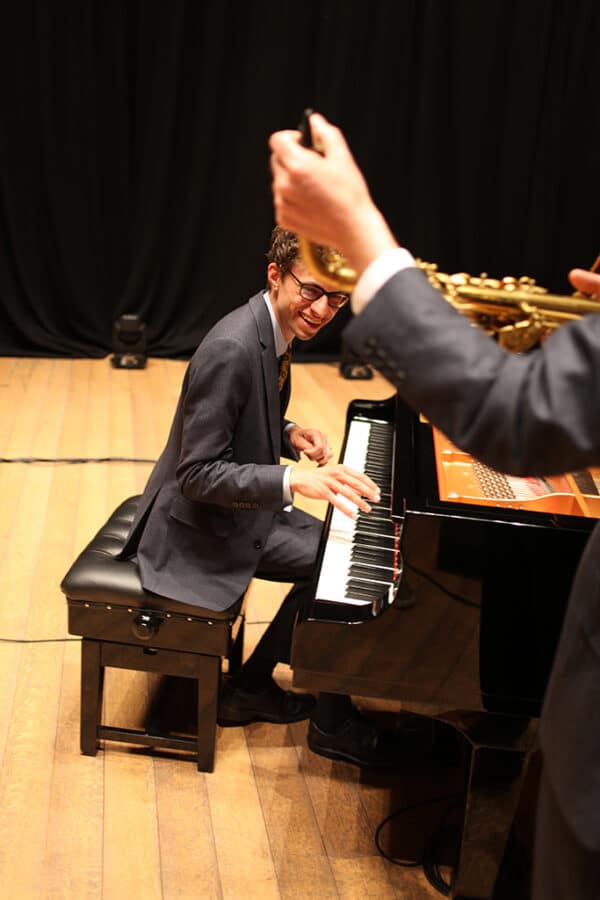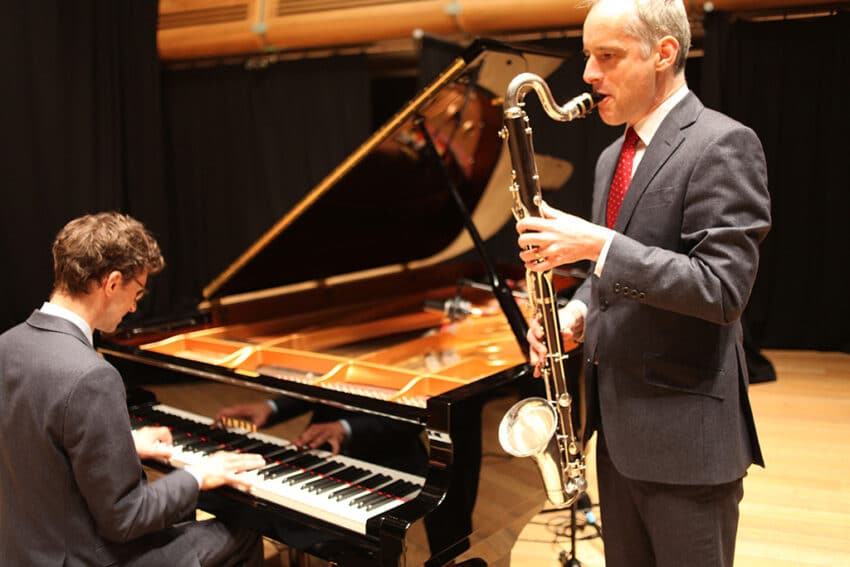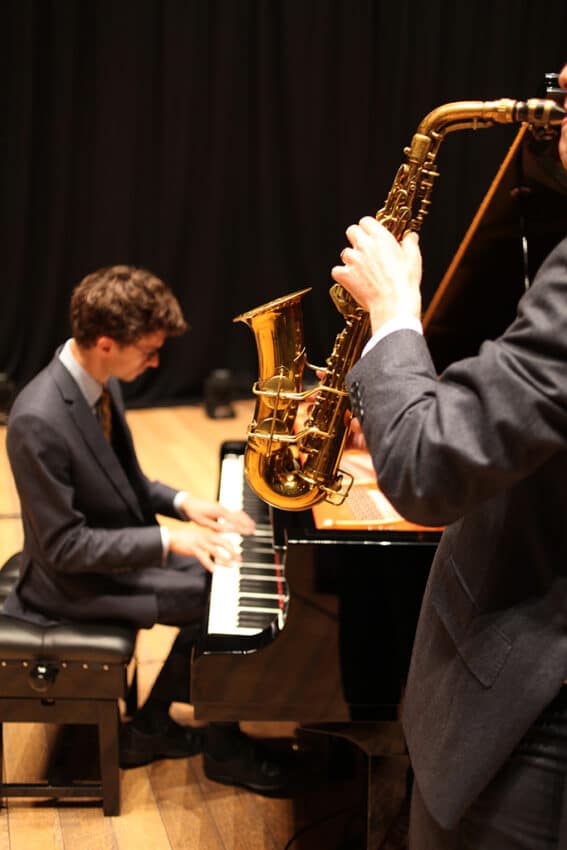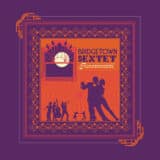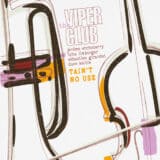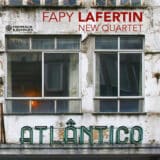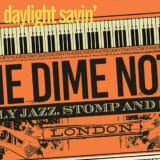The Complete Morton Project
A new perspective on one of America’s most important musical figures of the 20th century by Andrew Oliver and David Horniblow
Andrew Oliver and David Horniblow spent 2018 recording all of Jelly Roll Morton’s compositions, and each week posted two new tunes to this Youtube channel. Jelly Roll Morton was a jazz piano pioneer from New Orleans, and is regarded as the first great composer in the field of Jazz. Jelly Roll Morton was born Ferdinand Joseph LaMothe and lived from October 20, 1890 to July 10, 1941
DAVID HORNIBLOW – Clarinet
ANDREW OLIVER – Piano
COMPLETE MORTON TRACKLISTS & RECORDINGS
PRESS
Visit Andrew Oliver’s website
Visit The Dime Notes website
REVIEWS
JAZZ HALO NL 26.12.2019
Neglected masterpieces by the first great jazz composer
Ik vraag me af hoe het is om muziek te componeren in een stijl die zojuist is ontstaan. Ferdinand Joseph LaMothe (1890 – 1941), beter bekend als Jerry Roll Morton, heeft het gedaan. In het begin van de vorige eeuw ontstond in New Orleans de jazz, een kruisbestuiving van ragtime, blues, folk en negrospirituals, een mix van Amerikaanse, Afro-Amerikaanse, Creoolse, Europeaanse, Caribische en Zuid-Amerikaanse invloeden.
Met The Complete Morton Project gaan we terug naar de ontstaansgeschiedenis van de jazz met twee musici die hun sporen hebben verdiend in dit genre. Horniblow kennen we o.a. van zijn samenwerking met Acker Bilk en Kenny Ball en zijn bijdragen aan de populaire tv-serie Mr. Selfridge. Oliver is een van de oprichters van de Portland Jazz Composers’ Ensemble en de jaren ’20 en ’30 jazz en stompgroep, the Bridgetown Sextet.
Als de openingsmaten van het Shreveport Stomp klinken is meteen duidelijk dat de muziek uit de eerste decennia van de vorige eeuw nog steeds springlevend is. Horniblow en Oliver halen halsbrekende toeren uit op riet en klavier in een uptempo nummer dat prima kan dienen ter begeleiding van een doofstomme film. Het kenmerkende geluid van New Orleans is duidelijk aanwezig in de lange uithalen en het puntige pianospel in een nummer als Croc-O Dile Cradle. De bezwerende klanken van Horniblow voeren ons mee naar een reeds lang verloren wereld in het mysterieuze Gan Jam.
Met Fingerbuster manoeuvreert het duo zich in allerlei bochten in een bijna onmogelijk hoog tempo, terwijl de klaagzang I Hate a Man Like You zich tergend langzaam naar het einde sleept. Het contrast kan niet groter zijn. En wat te denken van een een nummer met een enorme zeggingskracht zoals Jungle Blues? Het nummer is in de uitvoering van Horniblow en Oliver bijna een minuut langer dan de in 1927 door Morton en zijn Red Hot Peppers op plaat gezette klassieker en wat we missen is de klap op de bekkens door Baby Dudds, maar wat we wel horen is een nieuwe standaard die wordt gekenmerkt door dezelfde dynamiek als het origineel.
Het is opvallend hoe divers de tempo’s, stijlen en stemmingswisselingen zijn die Morton bij elkaar heeft geschraapt om zich in dit nieuwe idioom te uiten. The Complete Morton Project is een uitgesproken album met werk van een uitgesproken componist. Al is het maar vanwege de uitvoering van zoveel ongekende, onberispelijk uitgevoerde klassiekers op een schijfje.
Al met al een prachtig project voor een nieuw label.
ROBIN ARENDS
VJM VINTAGE JAZZ MART 15.10.2019
The Complete Morton Project
Andrew Oliver comes from Portland, Oregon and David Horniblow from Reading in Berkshire; both studied and initially played classical piano and clarinet. Having turned to jazz, they worked their way through swing and more modern styles in their respective countries, but eventually returned to the jazz of the 20s, both determined to play it in the most authentic way possible. Oliver emigrated to the UK 6 years ago and they met by chance in London, where they formed the Dime Notes, a band that plays new interpretations of ‘20s and ‘30s jazz; and the Vitality Five, described in the liner notes as “a raucous group playing ‘20s small group stomps and jazz.” A couple of years ago, having featured a number of Morton’s best-known numbers, they decided to learn, play and record them all. You can hear the complete ‘book’ at the YouTube address at the head of this review. This CD offers a selection from the well-known to the utterly obscure recesses of Morton’s compositions, but in much better technical quality than is possible on the Net. Its stated aim is to show how, as the first true jazz composer, he fitted into the shift from early head-arranged jazz to the highly complex written arrangements of the later big bands. It’s worth remembering that Morton copyrighted Original Jelly-Roll Blues in 1905 – and that would have required a written version to be submitted. As the liner notes point out, many of his compositions were quite revolutionary for their time, and though he spent most of the 30s in near total obscurity, his final sets of recordings feature some fine 30s-style pop tunes; and a set of “fascinating big band manuscripts came to light in the 1990s”, which showed that he was not as set in his musical ways as many critics have suggested. One of these arrangements is featured on this CD
Now, there is no jazz figure dearer to my heart than Jelly-Roll Morton: I can have been little more than 3 years old when I first put Georgia Swing on the turntable of my uncle’s home-made electric gramophone, which I later inherited when he produced something more sophisticated to deal with vinyl. I somehow managed to play my way through his entire Morton HMV Memorial Album, without breaking a single one, which I also, in due course, inherited from him: remarkable, really, considering the several other priceless items that ended up in the waste bin! So this CD would, I hoped, be a real treat. And it is…
It kicks off with a spirited rendition of Shreveport Stomp, taken at a very fast tempo indeed, much faster than the original, and one which shows off Horniblow’s remarkable dexterity on the clarinet: he spills out an extraordinary array of arpeggios across one chorus in particular. Oliver’s piano provides not only a rocking accompaniment, but also re-creates very well Morton’s ability to shift the rhythm back and forth behind the soloist, creating a fine tension between the two players.
Croc-o-Dile Cradle is a piece I’ve never heard before. The sheet music was discovered by Vince Giordano, and it has been recorded by a couple of other bands. It’s a fine and quite intricate number, typically Mortonesque in its structure, and beautifully played here: the piano is especially good in its suggestion of how the composer would have rendered it. Oliver’s left-hand work is extraordinarily faithful to Morton’s style. Gan Jam is another obscure number, written as a big band score by Morton shortly before his death and is something of an experimental departure from his usual output. Horniblow adds bass clarinet on this track, which is an interesting mix of ‘jungle’ harmonies and much more modern semi-classical strains; it’s one of the least obvious Morton items, being much more modernistic in its structure and style – but also one of the most interesting and compelling on this CD.
Morton recorded State and Madison as part of his Library of Congress set; it’s a stately piece with, as the notes point out, “some unusual twists and turns.” Finger Buster, on the other hand, was one of the piano solos he recorded in 1938 in Washington, just before his first come-back session for Victor. It was one of several that were apparently made privately; Morton claimed Finger Buster was the most difficult jazz piano piece ever written; it certainly requires a lot of manual dexterity! What’s interesting, though, is that it works very well here, with Horniblow on the bass-sax, providing a Rollini-like rhythm line! Oliver turns in a tour de force but the sax is rather under-recorded. Courthouse Bump is one of the rarer Morton orchestral records: it perfectly suits the duet format and Horniblow’s bass clarinet line is beautiful.
Morton never recorded an instrumental version of Stratford Hunch: Louis Armstrong did, as Chicago Breakdown, though it was not issued until the late 30s. The version here remains more faithful to Morton’s solo conception, but includes part of Louis’ trumpet solo as a tribute. Mama Nita was likewise a piano solo, for Gennett in 1924, the same session that produced his solo version of the previous track. This one is notable for the dexterous interplay between the piano and clarinet across the habañera rhythm, the ‘Spanish tinge’ that Morton so often stressed was integral to good jazz.
With Good Old New York, we come to an example of the late Morton orchestral numbers he recorded for General Tavern Tunes in 1940, as he tried to compete in the ‘pop’ market of the time. It’s hardly one of his best efforts, though his own version is noteworthy for Albert Nicholas’ fine clarinet playing. Horniblow and Oliver make the best of this in a high-speed romp. By contrast, Freakish, one of Morton’s most distinctive and modernistic piano solos from the 20s, is a good vehicle for both talents: they once again delight in the cross-rhythms of the habañera. I Hate A Man Like You was written for Lizzie Miles, whom Morton accompanied on one of his rare side-man sessions, in 1929. As the liner notes remark, this is a dark, minor-key number, and it’s ideally suited to a small group format, where the brooding melody line is clear and incisive. The clarinet playing here has a strong emotional impact.
Another of Morton’s ‘darker’ orchestral recordings is Jungle Blues – written on a single chord, which ought to have made it much more popular with revivalists than it was! Here it’s a piano solo with, once again, a walking bass-sax rhythm line. Oliver gives a fine account of this under-performed number. With Black Bottom Stomp, we return to one of Morton’s big hits, played with great fire, but at such a breathless pace that the replication of the solos from the original is partly lost in the headlong rush to the final chord. There is, I think, a tendency to overestimate the tempo of Morton’s fast numbers (and probably those of other bands as well!): they’re almost always played slower than one remembers, and Black Bottom Stomp is no exception. Mr Jelly Lord is thankfully taken at a most stately pace: the bass-sax is much more audible here than elsewhere, backing some very fine improvisations on the piano and taking several good breaks. The CD closes with Morton’s last commercial recording My Home Is In A Southern Town. The piano line verges on an eight-to-the-bar rhythm and the clarinet contributes some excellent middle-register work on yet another little-known number. The Morton Sevens and Sextets are unjustly shunned by many collectors: I’ve heard them described as “just not Morton” – which is far from the truth. The fact is that Morton’s composing style and genius shines through on all these tracks; he wasn’t infallible, and some numbers are less successful than others, but David Horniblow and Andrew Oliver have rendered a great service to us all by rescuing so many compositions from obscurity and providing us with this selection from the complete canon, occasional Mortonian warts and all!
MAX EASTERMAN
LOS ANGELES JAZZ SCENE 11.10.2019
The Complete Morton Project
Pianist Andrew Oliver and clarinetist David Horniblow, who perform with several classic jazz units in England including the Dime Notes, made it a goal during 2017-18 to record all 93 Jelly Roll Morton compositions, posting them to You Tube. After having done that, they decided to record a CD featuring 15 of the Morton songs with an emphasis on the lesser-known tunes.
Jelly Roll Morton was not only one of jazz’s first major pianists, an important bandleader in the 1920s, and an early arranger, but he was arguably jazz’s first important composer. Many of the songs that he wrote during 1910-20 were far ahead of their time and he continued writing modern pieces in his own style up until the time of his death in 1941.
On this set of clarinet-piano duets which occasionally have Horniblow switching to bass clarinet or bass sax, the clarinetist sometimes recalls Omer Simeon (one of Morton’s favorites) while Oliver brings back the spirit and style of Jelly Roll. They perform two Morton pieces (“Croc-O-Dile Cradle” and “Gan Jam”) that were only discovered decades after the pianist’s death and never recorded by Jelly Roll. In addition, they revive nine other Morton obscurities along with four songs (“Shreveport Stomp,” “Jungle Blues” which is a pioneering one-chord romp, “Black Bottom Stomp,” and “Mr. Jelly Lord”) that are somewhat better known. The repertoire ranges from early in Morton’s career to the last song that he ever recorded in the studio (“My Home Is In A Southern Town”) including the joyous “Good Old New York,” the Latin-tinged “Mamanita” and his virtuosic piano workout “Finger Buster.”
This highly enjoyable set is available from www.lejazzetal.com.
SCOTT YANOW
JUST JAZZ 01.09.2019
The Complete Morton Project ‘Neglected Masterpieces by the First Great Jazz Composer’
Shreveport Stomp; Croc-O-Dile Cradle; Gan Jam; State And Madison; Fingerbuster; Courthouse Bump; Stratford Hunch; Mamanita; Good Old New York; Freakish; I Hate A Man Like You; Jungle Blues; Black Bottom Stomp; Mr. Jelly Lord; My Home`s In A Southern Town.
Andrew Oliver (piano), David Horniblow (clarinet, bass clarinet, Bass saxophone)
This is an essential C.D. for anyone interested in the music of Jelly Roll Morton, played by two musicians who are eminently qualified to perform Mr. Jelly`s complex music. American-born pianist Andrew Oliver, a music graduate of Loyola University in New Orleans and English clarinettist David Horniblow, who studied classical clarinet at the Guildhall School of Music.
The CD opens with a stunning version of Shreveport Stomp, taken seemingly even faster than the Morton trio recording. A foretaste of things to come. Next up is a recently discovered gem found by New York bandleader Vince Giordano amongst a box of sheet music acquired on eBay – the curiously-titled Croc-O-Dile Cradle. A medium-tempo stomp, it`s a real find, beautifully played.
Gan Jam is one of the few remaining compositions from Jelly`s last days, when he was struggling to rehearse a fourteen piece band in Los Angeles shortly before he died. Played here successfully in a reduction for piano and bass clarinet, it wouldn`t be an exaggeration to say that the full arrangement predates Charlie Mingus’ music of 20 years later.
State And Madison is a title Jelly recorded at the Library of Congress in 1938 – State and Madison – co-composed with Chas. Raymond and Bob Peary and copyrighted in 1926. Taken at a faster tempo than the L.O.C. recording, it works wonderfully. Finger Buster is next, performed expertly pretty much as Jelly`s solo recording, with bass clarinet accompaniment and then the next composition is the sadly often neglected Courthouse Bump recorded by Morton`s Orchestra in 1929. Great to hear it in this setting of piano and bass clarinet.
Next up is Jelly`s wonderful Stratford Hunch. Published by Melrose music as Chicago Breakdown – without the 8 bar intro and bridge – it was recorded by Louis Armstrong under that title and Louis’ 16 bar stop chorus is here included for clarinet.
Then we have the Spanish-tinged Mamanita, which Jelly recorded three times in piano solo, this version influenced – I would think – by all three. Next is Jelly`s 1938 Tempo Music publication Good Old New York taken at a fair pace and – to quote from the lyrics: “Knife and fork, bottle and a cork, that`s the way to spell New York”.
Freakish was first recorded as a piano solo in 1929, entirely successfully performed here in duet with clarinet. The composition I Hate A Man Like You was first recorded by Jelly with New Orleans singer Lizzie Miles, this performance capturing the brooding melancholy of that melody, and is quite beautiful.
During the next track Jungle Blues, the bass clarinet accompaniment achieves an almost vocal-like quality at times. Then the masterfully-performed Black Bottom Stomp, incorporating elements of the original recording throughout. Mr. Jelly would no doubt have approved.
And so to Mr. Jelly Lord, including the rarely played third theme. Incidentally, one of the tunes Jelly played in his Storyville days – according to fellow pianist Manuel Manetta – was a number called Play That Barber-Shop Chord the lyrics of which concerned one ‘Mr. Jefferson Lord’. I wonder…..?
The final title is My Home`s In A Southern Town which was published by Tempo Music whose director – Roy Carew – was the credited lyricist Ed Werac.
A wonderful CD – the result of a year`s intensive study of all available material – thus the title `The Complete Morton Project`. It`s good to know that Jelly Roll`s music is alive and well and – apparently – living in London.
The CD is available from, LeJazzetal, London, U.K.
RAY SMITH
JAZZ JOURNAL 09.08.2019
Andrew Oliver and David Horniblow: The Complete Morton Project
The Complete Morton Project unrolled on YouTube throughout 2018, at a rate of two tunes a week. It consisted of all 93 (or was it 94?) pieces known to have been composed by Ferdinand Joseph Lamothe, alias Jelly Roll Morton (1890-1941), played by these two hugely accomplished musicians. It was an epic undertaking and important for several reasons.
To begin with, it reveals the unexpected breadth of Morton’s stylistic range, from the stomps and blues of the 1920s to his very personal takes on the “jungle” style popularised by Ellington in the early 1930s, big-band music of the swing era and the classic American song form. Mostly, these later pieces were part of his attempt to get himself back into fashion, but the skill and ingenuity involved are undeniable.
Morton himself was a virtuoso and he made sure that in most of his compositions there was something that would not only demonstrate his superiority at the keyboard, but also show up the inferiority of anyone else brave enough to try. To ensure that the real thing got a hearing, he began making piano rolls of his own playing in 1908 and phonograph recordings from 1923 onwards. I have listened to quite a few of these alongside the Oliver-Horniblow versions and, take it from me, the playing on the latter would have made Jelly Roll Morton gulp. It’s not just that they get all the right notes in the right place, they do it with a confidence that seems almost casual at times. They put some of their own bits in, too, but they’ve got the idiom so well that you’d have to go back to the originals and check. I started doing that with Shreveport Stomp, but I was enjoying it so much I kept losing my place. So that’s another important thing: it’s brilliantly played and madly enjoyable.
As to instrumentation, Morton seems to have been happy to adapt any piece to what was available, and I imagine he would have been delighted with this duo. It’s mainly piano and clarinet (think Johnny Dodds, Omer Simeon and Volly DeFaut), but also, at times, piano and bass clarinet and even bass saxophone. No kazoos or jugs required.
It will not have escaped your notice that this CD, rather confusingly titled The Complete Morton Project, contains rather fewer than 93 pieces. That’s because it’s a selection, specially recorded in studio conditions, with a concert piano. The whole lot is still up there on YouTube (just search for Complete Morton Project), but the spacious, glowing sound of these 16 tracks is beyond anything that Jelly Roll Morton could have imagined in his lifetime. They lift his music out of the rarely visited bin marked “Early Jazz” and bring it unignorably to life.
DAVE GELLY
JAZZ LIVES 29.07.2019
DAVID, ANDREW, FERDINAND (THE COMPLETE MORTON PROJECT on DISC)
Internet commerce can feel awkward when one is attempting to say to prospective buyers, “You would enjoy spending money on this pleasurable rare object.” Or, in the new expression I just learned from a Swedish jazz friend, “smashing the savings pig.” Be not alarmed: purchase of this CD will not do any animal, ceramic or real, harm.
The CD in question is a beauty: “THE COMPLETE MORTON PROJECT / Neglected masterpieces by the first great jazz composer / ANDREW OLIVER / DAVID HORNIBLOW.” (lejazzetal Records: # LJCD21). For those who are already excited, the link to purchase or download is here.
I’ll let pianist Andrew explain:
David and I began playing together when I moved to London from Portland, Oregon, in 2013 and we quickly secured a weekly duo gig during which we learned a lot of Morton’s best known compositions. We’ve continued to work together frequently in the Dime Notes and the Vitality Five, and one day in 2017 as we added yet another fantastic Morton tune to the book of one of the bands, David suggested we should just learn them all! This seemed rather hilarious and we quickly started recording YouTube videos and posting them at a rate of two per week, with a goal to record and post all 93 tunes during 2018. Despite a fair bit of stress later in the year, we managed to complete this goal and decided to put down some of our favorites in the studio for this album. We’ve selected a cross section with a few well-known tunes and a lot of lesser-played ones demonstrating the full range of Morton’s compositional style and featuring David on bass clarinet and bass sax in addition to clarinet for some added textures.
The Morton compositions on the disc are SHREVEPORT STOMP / CROC-O-DILE CRADLE / GAN JAM / STATE AND MADISON / FINGER BUSTER / COURTHOUSE BUMP / STRATFORD HUNCH / MAMANITA / GOOD OLD NEW YORK / FREAKISH / I HATE A MAN LIKE YOU / JUNGLE BLUES / BLACK BOTTOM STOMP / MR. JELLY LORD / MY HOME IS IN A SOUTHERN TOWN — spanning the stylistic and chronological range of his career.
The jazz audience can be thrifty, so perhaps I should explain why JAZZ LIVES readers would consider purchasing this CD when Andrew and David have unlocked the treasure chest of Mortonia week by week with slightly under one hundred music videos. I can only say that, having followed the Complete Morton Project on video for about a year, I was delighted by what I heard on the CD. Whether you view the videos as master takes or alternates, there is vibrant lively improvisation on each song, so I did not feel that I was listening to familiar music, even though I knew both the Morton compositions and the Oliver-Horniblow interpretations from last year.
Second, the sound is beautifully spacious — even though the YouTube channel sounded just right, the CD sound is more expansive and detailed.
Third, and this is not a comic statement, you can listen to the CD in the car without endangering others or yourself. I would be alarmed if I got into a car with a Morton fancier who was watching the YouTube videos while attempting to drive us somewhere. LET ME OFF UPTOWN or DROP ME OFF IN HARLEM would come instantly to mind, euphemisms for “Stop right now!” So purchasing the COMPLETE MORTON PROJECT is not only an act of self-love; it’s good for pedestrians and other motorists. I rest my case. Buy it here.
Rereading what I’d written above, I wondered whether some would perceive it as flippant, which isn’t my intention. Although Andrew and David are great players and great imaginers, their joyous work is seriously rewarding. Morton’s work is so powerful — his compositions and his orchestral recordings as well as his piano renderings — that it seems to leave many musicians awe-struck and somewhat frozen. Thus, facing three minutes of architectural grandeur (say, the Victor BLACK BOTTOM STOMP) they are relegated to attempting to play the record through their own instruments in this century, and when such acrobatics come off, they are entrancing. (Almost no one I can think of has attempted the other kind of homage: “let’s play DEAD MAN BLUES as a boogaloo,” and that is all to the good.) What David and Andrew do and did is something else: their reductions of Morton (or, amplifications, if you consider those duo performances based on piano solos) seem to say, “We know this material is strong in every way: melody, harmony, rhythm. Let us, as if we were restoring an irreplaceable eighteenth century painting, strip off all the accretions, all the layers of performance practice, all the flourishes that come from taking records as sacred text, and concentrate on the Music. Let us also see, in the best New Orleans – Chicago – New York style, what our warm imaginations can bring to this song.”
Thus they venerate Morton but also play him, with wondrous results.
The link to see, hear, purchase other lejazzetal CDs — including four delightful ones by Martin Wheatley and friends; the Dime Notes; the Vitality Five, and more — is here.
MICHAEL STEINMAN https://jazzlives.wordpress.com
THE SUNDAY TIMES 28.07.2019
The Complete Morton Project
Jelly Roll Morton was never shy about singing his own praises, but today he often doesn’t get the credit he’s due as a jazz composer. Kudos to this British-based piano and clarinet duo — more often seen as part of that elegant outfit the Dime Notes — for plunging into the repertoire. Starting out with the goal of recording all Morton’s tunes on YouTube (a fascinating watch, by the way), they’ve now boiled down the selection to a mix of standards and less familiar pieces. Compelling, soulful and huge fun.
CLIVE DAVIS
THE SYNCOPATED TIMES 21.07.2019
The Complete Morton Project
The Complete Morton Project refers not to the completeness of this particular album but to the lofty goal of its participants to learn and record as a duo all 93 of Jelly Roll Morton’s compositions, including his rarest.
In 2018, they began posting YouTube videos of their arrangements recorded in an apartment and the delicacy and buoyancy of their performances attracted jazz fans the world over. Both musicians on the screen were however already established and well known in the field. They’ve even played together in The Dime Notes, and more recently The Vitality Five, highly respected traditional jazz bands with slightly different focuses.
Andrew Oliver is a pianist from Portland Oregon who got his start in classical piano, fell in love with ragtime and early jazz, and studied music at Loyola in New Orleans just before Hurricane Katrina. In 2007 he toured Africa with Jazz at Lincoln Center. When he got home he founded the Portland Jazz Composers’ Ensemble and toured with groups playing both modern chamber jazz and traditional jazz before relocating to London in 2013 and concentrating his efforts solely on the early styles. He draws on the greats for inspiration which made this project a natural fit. In fact, the light bulb went off when he and Horniblow were rehearsing yet another Morton piece to add to the repertoire of their full band.
David Horniblow is from Reading in the UK and studied classical clarinet. He started his jazz career playing swing and modern styles, but his first fascination had been early Duke Ellington. He followed up an opportunity to play with Keith Nichol’s by joining the Chris Barber Band. He’s played with Acker Bilk, Kenny Ball, and all the legends of British Trad still active during his tenure. In addition to his work with The Dime Notes and The Vitality Five, he leads Horniblow’s Hot Three and appears with a number of other traditional jazz acts active around London.
Though this project may have started on YouTube this album was recorded in a professional studio under the best circumstances. Oliver had use of a Steinway grand piano, Horniblow occasionally grabs the rarely heard bass sax. Having the Youtube versions available is no reason not to treat yourself to this disc. Comparing both gave me a fine appreciation of what a studio offers, even at the expense of that spontaneous bedroom feel. The pure musical beauty on display in the videos suffers not at all for the better acoustics.
Extensive liner notes written by Andrew Oliver accompany attractive packaging from the lejazzetal label. They explain that to explore the Morton compositions is to explore the very earliest stew of New Orleans jazz, including elements of blues, Spanish influences from the Caribbean, the inspirations of ragtime improvisers, and the musical understanding of classically trained Creoles like Morton himself. While Morton’s claim to have invented jazz is dubious he was the first of the great jazz composers, and because most even into the early 20s weren’t putting their jazz creations to paper his record is an important glimpse at the past and a continuing source of inspiration for those wishing to explore it.
Says Oliver:
“Morton’s early compositions… show an advanced compositional mind at work, creating unique and complex forms, sweeping melodies and potent counterpoint and, most importantly, allowing for improvisation and variation in a true jazz style, all before 1920!”
This 15 track release includes the most obscure Morton while also covering the full length of his career. “Good Old New York” has Morton sliding into the 30s tin pan alley pop market. To draw attention to the Spanish tinge they include “Mamanita”, dedicated to a lady Morton pursued at two different stages of his life. “Jungle Blues” is a one-chord tour de force that shows him decades ahead of his time. Oliver and Horniblow play it with the power of a full orchestra. In fact, they amaze with the depth, nuance, and rhythm they draw out of each of these titles.
Covering everything as a duo leads to some unusual situations. Late in his career, shortly before his death, Morton wrote some arrangements for big band that were only unearthed in the 90s. They have since been recorded at the proper scale but for this album, one of them, “Gan Jam”, had to be pared down to fit a piano duo. “Croc-O-Dile Cradle” was only recently discovered in Vince Giordano’s massive collection of arrangements. The Fat Babies recorded it for their band but we hear it here in concentrated form.
Not everything on the disc is a rarity, they lead off with the familiar “Shreveport Stomp”. It’s a smart way to bring the audience on board. Late in the album, they also include “Black Bottom Stomp” and “Mr. Jelly Lord”, which captures Morton’s famous braggadocio.
This is an album of pure traditional jazz that is getting well deserved recognition far beyond our walled confines, and for good reason. Oliver and Horniblow play with a freshness and creativity within the style that is undeniable even to those who wouldn’t normally have ears to hear. What these two accomplish with these compositions is a testament to Morton’s greatness but also to their own unquestionable talent and to the power of jazz itself to be ever new, raw, and moving.
JOE BEBCO
JAZZ WAX 10.07.2019
The Complete Morton Project
New Orleans pianist Jelly Roll Morton is widely considered to be jazz’s first arranger. Though jazz was considered an improvised form early on, Morton proved that jazz could retain its joyous, freewheeling feel even when scored on music paper. He also was jazz’s first published composer. His Jelly Roll Blues was published in 1915. As a composer, Morton was a powerful force, writing the standards King Porter Stomp, Wolverine Blues and Black Bottom Stomp. He also was among the first jazz musicians to be ripped off in a sizable way.
Despite having written dozens of songs that had been recorded and performed with great success by other leading bands since the start of the swing era, Morton had consistently been denied membership in ASCAP. As a result, he didn’t receive a dime in royalties for the performances of his music in concerts, on jukeboxes and on the radio. In the 1930s, ASCAP was exclusively for Broadway’s white, legit songwriters whose songs generated sizable income in New York and Hollywood.
During this period, jazz was thought of as junk music by ASCAP, which considered the originality of jazz compositions suspect, since the blues was a public domain construct. It wasn’t until 1939, with the formation of BMI, that musicians who played jazz, R&B, country, blues and other popular folk styles found a performing rights organization that welcomed their membership and protection.
Getting back to Morton, who died in 1941, a sensational new album has been released by two extraordinary musicians—pianist Andrew Oliver and clarinetist/saxophonist David Horniblow. The album is The Complete Morton Project, featuring 15 songs by Morton. The tracks represents a fraction of what’s coming. Oliver and Horniblow have recorded all of Morton’s original songs, which number around 95. One suspects more will appear as funding becomes available. The songs on this first album are Shreveport Stomp, Croc-O-Dile Cradle, Gan Jam, State and Madison, Finger Buster, Courthouse Bump, Stratford Hunch, Mamanita, Good Old New York, Freakish, I Hate a Man Like You, Jungle Blues, Black Bottom Stomp, Mr. Jelly Lord and My Home Is in a Southern Town. To learn more about each individual song, visit Andrew Oliver’s site, where he has posted about them.
What you hear on this new album are two excellent musicians embracing the musical life of a jazz icon who was short-changed while he was alive. The Complete Morton Project not only lets us hear the breathtaking quality of Morton’s piano (thanks to the magnificence of Oliver) but it also serves up the piano with reeds (thanks to Horniblow) clear and vibrant, with all of the excitement intact. Most of Morton’s original recordings suffer from the limitations of technology in the 1920s and ’30s. Now, with this new album, we finally can hear Morton’s original work with the sonic grime wiped off. The result is spirited foot-tapping music that illustrates a turning point in the evolution of syncopation and the emergence of a piano sound that emulated the jazz orchestra.
MARC MYERS
JAZZ DA GAMA 02.07.2019
A soundtrack for what is almost a period narrative using the rarest of rare material
American pianist Andrew Oliver and British reeds and woodwinds player David Horniblow have been heard together recently as part of The Dime Notes, a group dedicated to playing in the tradition of Jazz; playing music that is specifically dedicated to preserving the New Orleans style. In fact Mr Oliver is a pianist almost completely immersed in the New Orleans style of playing, a relative rarity these days. For his part Mr Horniblow is no less immersed in that style of playing and indeed his playing often evokes the high and lonesome clarinet of George Lewis and Barney Bigard. So it seemed almost a foregone conclusion that the two musicians would get together to traverse that time when the style of playing was most prominent – at the turn of the 20th century, that is.
The welcome surprise is that the duo should make their journey one that uncovers hidden, rarely played and perhaps even lost compositions by the great Jelly Roll Morton. A “surprise” but also something that is crying out to be heard, not only because it would appear that there is a contemporary trend in music to play improvised music and pass it off as Jazz. Musicians are just as guilty of doing so as are music industry executives with precious little knowledge of the history of Jazz. The result is a burgeoning music industry that tries to pass itself off as something that it isn’t; in this case – “Jazz”. On the flip-side, when a recording as masterful as this one comes around, one should be at the ready to recognize its importance, its authenticity and its remarkable beauty.
Jelly Roll Morton was a seminal figure who ruled the roost, so to speak, when Jazz was young, even going so far as to claim that he invented the art of Jazz. Truth be told, he was responsible for a number of “firsts” including recognising the importance of “the music ensemble” and writing idiomatically for the several instruments that made up this (then) so-called Jass “ensemble”. He was also the first to make the connection between classical forms, the Blues, and was almost alone in bringing Spanish traditional forms from Afro-Caribbean music into Jazz – or what he now-famously called “the Spanish tinge”. Best of all, Mr Morton brought together Black American music – the Blues – together with European forms; perhaps even create the first Jazz composition.
Mr Oliver and Mr Horniblow have done remarkable work in transcribing some of Mr Morton’s all-but-forgotten; even so-called “lost” work in this breathtaking hour-long disc. But more than reminding us where the music of Jazz comes from, this disc creates the vivid soundtrack for what is almost a period narrative using the rarest of rare material. The duo operates as a partnership of equals and supplies the ear-worms throughout. Mr Morton’s compositions are, of course, the main attraction – dancing melodies, insistent rhythms and breathtaking harmonies with the added attraction of breathtaking harmonies tossed from pianist to reeds/woodwind player and back in a devilishly brilliant manner.
The music of Jelly Roll Morton is proudly flown as the flag of the seminal music of Jazz throughout. But even if the music is the main attraction one cannot help being struck by the invention of each of the musicians playing here; Mr Oliver, for his part maintains swagger and swing through each interpretation holding fort especially in the long inventions of “Jungle Blues”, for instance. Mr Horniblow, for his part, plays clarinet and bass clarinet – as well as the lugubrious bass saxophone played here with tremulous delicacy on “Mr Jelly Lord” – with lithe and elegant warmth and swing weaving the tantalizing symmetry of Mr Morton’s melodic lines masterfully into the grand scheme of the songs. Both performers negotiate Mr Morton’s diabolical music with expertise, eloquence and good taste that is both rare and welcome music today in this worthy tribute to one of the great pillars of Jazz – Jelly Roll Morton.
RAUL DA GAMA
THE OBSERVER 30.06.2019
the joy of Jelly Roll
Have you seen those two guys on YouTube? They’re fantastic!” The word got round last year about pianist Andrew Oliver and clarinettist David Horniblow, who had set themselves the apparently lunatic task of learning all the 94 compositions of Ferdinand “Jelly Roll” Morton and recording and posting videos of the whole lot by the end of 2018. Not only did they succeed, their playing was so dynamic and heartfelt that I really missed them when they’d finished.
I thought I knew Morton, the first jazz composer, pretty well, but some of what these two had played was quite new to me. More important, their approach, although perfectly authentic in style, had a freshness and immediacy that was all their own. These 15 numbers, rerecorded in a proper studio, with a concert piano, make an impressive selection from a fascinating life’s work.
Morton (1890-1941) started out playing ragtime in New Orleans brothels, becoming a popular bandleader and recording artist in the 1920s, only to fall out of fashion in later life. Nowadays he tends to get patronisingly labelled as “early jazz”. These spirited and accomplished performances bring his music vividly to life.
DAVE GELLY

